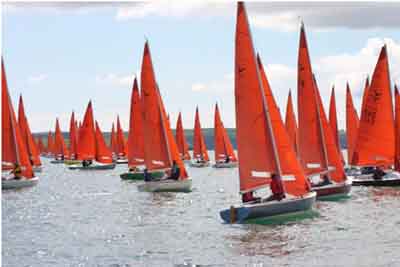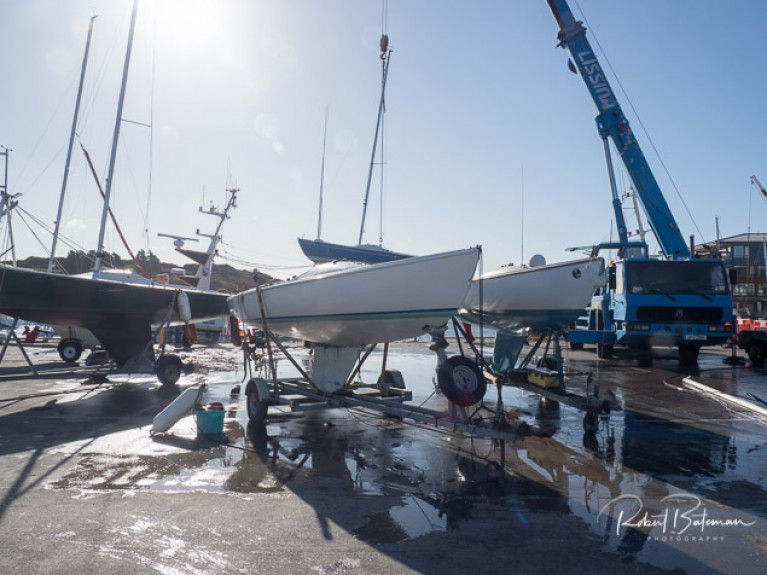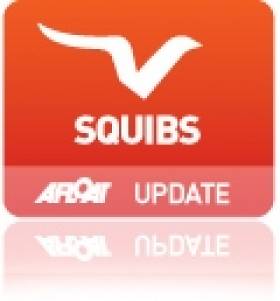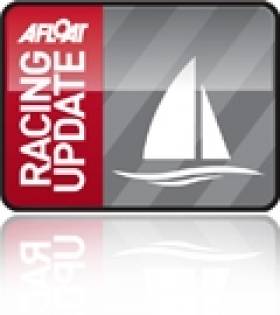Displaying items by tag: Squib Class
Tight Battle for National Squib Keelboat Title in Weymouth
Race seven of the National Squib Keelboat Championships in Weymouth was in total contrast to the previous races.
The wind blew off the shore between 4 and 12 knots and shifted to sixty degrees.
Of the 65 competitors, Ireland's ‘Femme Fatale’ with Vincent Delany and Joe O’Byrne rounded the first windward mark in about 8th place. But missed a few of the shifts over three laps of the 1.2-mile beats and finished in 16th place at the end of the 90-minute race.
Kinsale's Ian Travers and Keith O’Riordan in ‘Outlaw’ handled the unstable wind with panache, finishing in 14th place.
‘Volante’ from Killyleagh finished in 35th place while ‘Slipstream’ took 40th place.
Overall there is a tight battle between Jono Browne in ‘Two Counts’, who has used up all his discards and Tom Jeffcoate and Mark Hogan in ‘Ric-O-Shea’, who are six points behind.
Friday will be the last race of the Squib Keelboat championship in Weymouth.
Results here
Four Irish boats compete at the Weymouth Squib National Championships this week.
Sunday saw a practice race followed by the first championship race.
Winds started light and built up to 16 knots from the SW with beats in excess of one mile on a windward-leeward course in Weymouth Bay.
The Irish boats are racing are Femme Fatale, 24, Vincent Delany and Joe O’Byrne; Incendio, 33, Josh St. John; Slipstream, 102, Robert Marshall and Fiona Ward; Volante, 807, Simon Watson and Geordie Withers and Outlaw, 785, Ian Travers and Keith O’Riordan
Results are here
Cinnamon Girl Offshore Duo Win Squib Frostbite Race at Kinsale
Cinnamon Girl, the two-handed cruiser crew of Sam Hunt and Cian McCarthy, sailed the Squib, Breakaway, to first place in the first race of Sunday’s Custom Rigging Frostbite Series at Kinsale Yacht Club.
This was the second day of racing, but the duo were outpaced in the next two races of the day by Outlaw, sailed by Ian Travers and Keith O’Riordan, which has taken over leadership of the Custom Rigging Frostbite Series.
The Breakaway crew finished in fifth and third places in those two races.
With one discard applied after six races, Outlaw leads the league with a total of just seven points.
Second overall are Colm Dunne and Fiona Ward, sailing Allegro. They had a hat-trick of second places in Sunday’s three races. and now have a total of twelve points. Behind them, placed third on eighteen points, are Matthias Hellstern and Colm Daly sailing Fifty Shades.
The Breakaway crew are placed 9th overall on a total of 37 points.
Last week’s league leaders, Michael O’Sullivan and Micheál O Suilleabháin, did not race on Sunday. Carrying a points penalty applied for not competing, have dropped to 7th of the thirteen boats racing in the league, which continues until Sunday, March 5.
Second overall are Colm Dunne and Fiona Ward, sailing Allegro. They had a hat-trick of second places in Sunday’s three races. and now have a total of twelve points. Behind them, placed third on eighteen points, are Matthias Hellstern and Colm Daly sailing Fifty Shades. The Breakaway crew are placed 9th overall on a total of 37 points.
See a photo gallery of the series here
Northern Ireland Sailors Find it Better Not to Argue with Lough Derg Gusts at Freshwater One Design Regatta
The Lough Derg Freshwater One Design regatta last weekend was, for most, a two-day event reduced to one, and for the Northern Ireland sailors who made the long journey to Dromineer somewhat disappointing, especially for the Belfast Lough Flying Fifteen entries, Bryan Willis and Trevor D’Arcy.
But it would seem it was better not to argue with the gale force gusts on the Saturday of the eighteen Flying Fifteens entered, ten actually turned out. Of those, one of the Northern boats, Bryan Willis and David McFarland in Simply Gold had a frightening experience when Bryan was swept overboard while hoisting the spinnaker and got tangled with the spinnaker sheet as the spinnaker was still up. As it was trying to fill, it pulled the sheet tightly around him. The County Antrim Yacht Club helm Bryan said, “ If David moved from the weather side to try to pull me in, the boat threatened to capsize on top of me. It was a relief to be rescued by the Safety Boat”. He continued, “All the boats that went out on Saturday got into trouble at some point, and one was completely upside down”.
 Bryan Willis in Simply Gold (4074) neck and neck with Trevor D'Arcy in Don't Look Back (3782) in the lighter winds on Sunday at Lough Derg Yacht Club's Freshwater One Design Regatta Photo Olly Kierse
Bryan Willis in Simply Gold (4074) neck and neck with Trevor D'Arcy in Don't Look Back (3782) in the lighter winds on Sunday at Lough Derg Yacht Club's Freshwater One Design Regatta Photo Olly Kierse
Trevor D'Arcy and Alan McLernon from Carrickfergus, also on Belfast Lough, did finish, though, at second behind Niall and Ronan O’Brien. But they retired from the second race.
As Afloat reported earlier, Sunday’s conditions were the opposite, with light fluky winds, and on that day, D’Arcy scored another second, 6, 5 and 10 to finish fifth overall. Willis and McFarland redeemed themselves with a 2,3, 6 and 8 to finish ninth.
Some of the Northern Ireland Squib fleet, decided not to travel, leaving the Strangford Lough entry, Robert Marshall from Killyleagh, along with Peter Wallace Gordon Patterson, Terry Rowan and Stephen Stewart from Royal North of Ireland YC on Belfast Lough to compete in the 32 strong fleet.
With no racing on Saturday, all of day 2’s four races counted and coming out on top by one point was Royal North’s Toy for the Boys with Peter Wallace and crew Fiona Ward from Kinsale. Peter won the 2018 Squib Nationals at Royal Irish. Runner up was David Stewart in Granat from Royal Irish with the far travelled Dick Batt from Royal Victoria YC on the Isle of Wight in third slot.
The other Northern Ireland Squibs who travelled to Dromineer finished at eighth, 11th 12th and 13th, respectively: Terry Rowan in Dogwatch, Stephen Stewart in Second Chance, Gordon Patterson’s Fagin (last year’s winner), all from Royal North, and Slipstream with Robert Marshall from Killyleagh. Patterson’s crew Ross Nolan said, “ It was great to get back to Dromineer for the annual season closer and catch up with everyone. Challenging racing in light and shifty conditions, especially with shorter races due to the compressed schedule. This was typical close Squib racing and another great regatta”.
Result sheets are downloadable below
Lough Derg Freshwater Regatta Organisers Keep Look Out for COVID-19 Restriction Changes
Just as Ireland's one-design keelboat classes were gearing up for the last blast of the season this weekend, anticipated COVID-19 restriction hikes are threatening the staging of the annual regatta at Dromineer in County Tipperary.
Flying Fifteens, Dragons, Squibs and SB20s are all scheduled to compete.
Organisers of the traditional end of season freshwater regatta at Lough Derg Yacht Club (9-11th October) will be watching out for COVID-19 level announcements today. The much-anticipated hike in restrictions aired on Sunday night (NPHET advice for a countrywide Level Five lockdown) would bring the curtain down on the popular autumn event that typically sees boats travelling from Northern Ireland, Dublin, Cork and other ports for the three-day event.
Some of Dublin's One Design keelboat classes are hoping that current Level 3 restrictions due to expire this Friday will allow travelling out of the county for the last sail of the season. All Dublin club racing has been cancelled over the last three weeks due to the county-wide restrictions.
Lough Derg Yacht Club has posted a Notice of Race with the rider that the 'Club reserves the right to cancel this event with short notice and all fees will be refunded' if it cannot go ahead.
In Kinsale, Squibs were hauled out at the weekend in anticipation of the Squib Inland Championships that are being held as part of the Lough Derg event.
Squib Keelboat Class Agrees To Modernise
#squib – There are developments afoot for The Squib keelboat following a recent ballot of boat owning members. The Squib Class voted overwhelmingly in favour of rules change to improve and modernise the design.
The class will stage its 2015 British and Irish Championships in Howth, County Dublin this Summer. Over 70 boats are expected to compete.
Final proposals are now being agreed with the RYA prior to work commencing on new moulds and a prototype, which we hope to complete in time for it to be sailing at the Class National Championships at Howth.
The improvements are intended to enhance the Class without outdating any existing boats. There are a number of construction and fitting improvements including a self draining cockpit.
The low maintenance construction system will comply with the requirements of Recreational Craft Directive (RCD). The hull form and sail plan will remain unchanged but the Squib will have a 'fresh, more modern feel' and benefit from a quality construction method.
The self draining cockpit is a major safety improvement and will allow Squibs to both sail and be left on moorings without the need for bailing out, thus making the Squib more user friendly for racing, cruising, and for use by sailing schools.
The Squib has been in existence for more than 46 years and continues to be a successful small keelboat for racing and coastal day cruising. 65 plus boats competed at the 2014 National Championship and 31 boats started on the line at last year's Cowes Week. The Squib Class was overall Class winner at Cowes Week 2014.
More on the UK site here. For more on Irish Squib sailing read WMN Nixon's blog
#squib – The Royal St George Yacht Club hosts the Irish Squib East Coast Championship 2014 from 24-25 May 2014 writes Squib captain Rupert Bowen.
The Dun Laoghaire class welcomes Squib sailors back to the club, which hosted the Irish Squib Nationals in 2012 with 32 entries and the UK Squib Nationals in 2010 with over 70 entries. 15-20 entries for the Easterns this year, although it could be more (32 boats entered the Squib Inlands in Dromineer last October)
The plan is to run five races over the two days and to award prizes after racing concludes on Sunday 25th May.
The Squib is a 6m keelboat that can appeal to a wide range of sailors and levels of experience, age etc. There are active and growing Squib fleets all around Ireland and Great Britain. In the Dublin Bay fleet we have teenagers and retired men and women and all ages in between! We have sailors who have competed at the highest level internationally as well as people who simply enjoy a race "around the cans" in Dublin Bay. We race around the buoys in Dublin Bay on Tuesday, Thursday evenings and around "Olympic" dinghy courses on Saturday afternoons.
Sun Shines on Dun Laoghaire Squibs
More than 70 boats and 400 sailors, their families and friends from Ireland and the UK converged on Dun Laoghaire this weekend for the start of the biggest event in the sailing calendar in Dublin Bay this year. All the photos (by Gareth Craig) from Race one of the Squib National Championships are here.
Squib Class
History (the following information and image courtesy of the National Squib Class Owners Association)
The Squib was designed in 1967 by Oliver Lee as a successor to his Ajax 23. The protoytpe was built in cold moulded wood and sailed extensively over the winter of 1967-68. After successful proving trials she was used as a plug and the first GRP Squib was launched in June 1968. By the end of that year there were six Squibs racing on the Crouch and they had grown into a substantial fleet by 1969 with new fleets forming at Waldringfiled, Brixham, Abersoch and Aldeburgh. At the Yachting World Keelboat Rally held in 1969 the Squib was pronounced to be the most interesting entry. When numbers passed 300 in 1972 the Squib was granted national status.
 While the UK fleets expanded, interest began to spread abroad. A couple of Squibs went to Tortola as day charter boats and a fleet grew there. Other groups grew in South Africa, Greece, Germany and Australia. Many of these boats were either club owned, operated on charter or used in sailing schools.
While the UK fleets expanded, interest began to spread abroad. A couple of Squibs went to Tortola as day charter boats and a fleet grew there. Other groups grew in South Africa, Greece, Germany and Australia. Many of these boats were either club owned, operated on charter or used in sailing schools.
By 1974 sail numbers had approached the 400 mark despite growing economic gloom. That November an event called the Squib Symposium was dreamed up by Simon Fraser, and that country's leading yachting journalists came to Burnham-on-Crouch to race Squibs against one another. The resulting press comment further enhanced the Squib's reputation as did the Design Centre's decision to put the Squib on its index of selected designs.
The Class has now spread to all parts of the British Isles, where there are 27 active racing fleets, ten of which muster more than 20 boats. The most recent fleets to be formed were at Royal Ulster YC in 1998, East Antrim YC in 2000 and Kinsale YC in 2001. The Royal Ulster YC fleet now embrace Squibs from Ballyholme YC and the combined fleet is called the Bangor Fleet. Over 810 Squibs have been built and the National Squib Owners Association has over 640 members. A National Championship has been held at a different venue every year since 1972. In 2002 it was held at Royal North of Ireland YC with an entry of over 80 boats. A Match Racing Championship which was instituted in 1988 was held at Howth in 2000 but was not sailed in 2001. In 1995 Rutland SC instituted an Inland Championship which attracted 34 entries and proved so popular that it has been held every year since and in 2002 attracted 43 entries. Squibs race as a class in Aldeburgh Week, Medway Week, Menai Strait Fortnight, Oulton Week, Tay Week and racing with a PY of 115.
Until his death in 1993 Oliver Lee was the sole licenced builder of Squibs. The licence lapsed on his death and in 1994 it was granted to Barker Brewer Boats Ltd but they relinquished it in 1996 after having built 12 Squibs. In 1997 the licence was granted to parker Sailboats who built 40 squibs up to the end of 2001.
What is a Squib?
Just under 20 foot long, the Squib is a two person racing keelboat with 50% ballast ratio. That means it is big enough to race at sea and small enough to trail comfortably behind a family car. It also means that it needs only two of you to race and it is very safe in a blow. The Squib is sailed by all sorts and by all ages, primarily because it is, and feels, so solid and safe. You sit in a Squib, not on it – though we do hike out!
It is particularly suitable for mixed crews. About 10% of helms at the Nationals are female as are 25% of all participants in the Nationals. The 2007 National Champion crew is Penny Fenwick. Jenny Riley has been twice National Champion crew and recently won Oulton Week as a helm. There are very many married couples racing in the Squib Class.
The Squib seems to suit all ages as well. The youngest crew at the Nationals in 2007 was 13. The youngest helm we have seen was 12 (Holyhead 2004.) Prizes are awarded for first boat with crew combined age over 120. (To win this, the boat would have to be in the top third of the fleet.) The oldest Nationals competitor we are aware of was 85 at the time.
About 80–100 Squibs attend the National Championships which take place at a different venue each year (2008 Lowestoft, 2009 Weymouth, 2010 Dun Laoghaire.) 55 attend the Inland Championships which are held at Rutland and there are usually about 35 Squibs racing in Cowes Week.
There are many other championships – the Irish, Northern Irish, Scottish, North of England, East Coast, South Coast and the Welsh Championships. Squibs sail in many regattas around the country – Oulton Broad, Menai Straits, Aldeburgh, Bridlington, Abersoch, Dart and several others.
Squib Class, c/o Jill Fleming, President, Rathdrum Cottage, Ballycorus Road, Shankill, Co. Dublin. Email: [email protected]
In March 2009, Graham Smith wrote the following review of the class for Afloat: "According to the stats, the Squib national fleet stands at 85 which represents an increase over the previous year so the appeal of the boat – affordable, easily trailed and easily sailed – is clearly catching. Indeed, the Irish fleet represents a fair percentage of the total fleet in the British Isles.
Interest has been growing over the years so that it’s no longer a Howth and Cultra monopoly, with burgeoning fleets in Killyleagh, Arklow and Glandore in West Cork.
That said, the northerners still tend to dominate proceedings on the race course and John Driscoll from RNIYC won the national title from a healthy fleet of 36 boats, sailed in Kinsale. National Champion 2009: John Driscoll, RNIYC
There is a space for Irish boating clubs and racing classes to use as their own bulletin board and forum for announcements and discussion. If you want to see a dedicated forum slot for your club or class, click here

































































